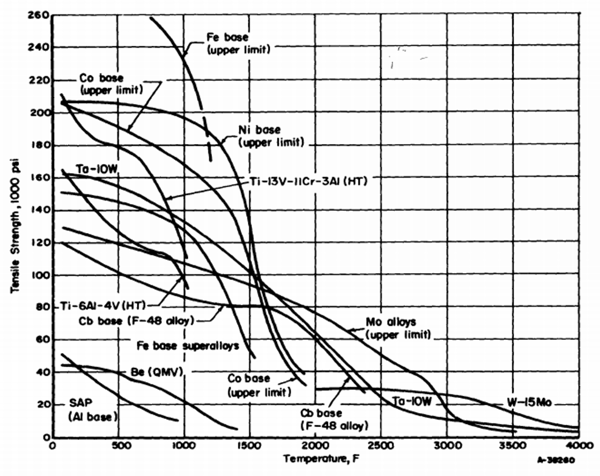Temperature envelopes in the turbomachinery industry are constantly increasing as the state of the art evolves in pursuit of better performance. This means engineers need to design compressors with higher and higher exit temperatures, and turbines and nozzles with continuously increasing inlet temperatures. This rise in temperature greatly impacts the selection criteria for materials used.
The availability of a suitable material can be the limiting factor in determining whether the extension in temperature envelopes is possible. One of the most critical mechanical properties is the strength measure of the material, particularly at elevated temperatures, and if weight considerations are of import, the specific strength of the material (strength measure divided by material density).
The two most commonly used measures to characterize material strength are the material yield strength and ultimate strength. The material yield strength is the stress beyond which the material, if loaded monotonically, deforms permanently. Any distortion accumulated beyond this "yield point" of the material is irrecoverable or "inelastic". The ultimate strength of the material is the stress value at which rupture occurs and the material undergoes fracture—complete failure. In most engineering design applications for metallic structures, only small (elastic) deformations are permissible. This is because the part might be equally dysfunctional if deformed permanently as much as it would be if it were to fracture or rupture. The material yield strength is therefore used as the strength measure criterion in common practice to determine safety margins when evaluating structural feasibility.
As you might guess, both the material yield and ultimate strength generally degrade with increasing temperatures for metallic alloys. This trend for decrease in strength versus temperature is illustrated for typical alloy systems in the figure below. So, as peak service temperatures for compressors and turbines increase, the stress margins at critical locations (blade hub, bore, backface etc.) become slimmer and slimmer for any given loading.
Elevated-Temperature Tensile Strength According to Alloy System (From Introduction to Metals for Elevated-temperature Use)
Material scientists and metallurgists have put in a lot of effort to design superalloys that have enhanced elevated-temperature properties, strength in particular. The aspects of the material microstructure that govern the yield strength characteristics of metallic structures, and what processes are employed to modify this microstructure to obtain better yield strength for alloys, is worth exploring.
Metallic alloys exhibit an orderly crystalline microstructure and plastic deformation occurs at these microstructural defects. These are termed as dislocations, and they are able to move under the application of external load. The higher the yield strength of a material, the higher its ability to resist plastic deformation, and therefore, the resistance to motion of dislocations. Various strengthening procedures can be employed to increase the resistance of motion of these dislocations and thus increase the material yield strength. The increase in yield strength, however, comes at the cost of ductility, and the strengthening process is also alternatively termed as material hardening. An increase in material yield strength for single-phase alloys can be achieved through several methods, such as grain size reduction, solid-solution strengthening by alloying with various metal combinations, and strain hardening by performing cold work on the metal. For multiphase alloys, other techniques such as precipitation hardening through phase transformations by specifically designed heat treatments are utilized. All of these techniques involve the same fundamental goal at the material microstructural level, albeit through differing mechanisms. They are all designed to resist the motion of dislocations and hence plastic deformation. The benefits of these increases in yield strength also extend to elevated temperatures.
The continuous development and enhancement of high-performance turbomachinery with elevated service temperatures hinges heavily on advancements in material capabilities, designed for elevated-temperature use. Some experts think that the groundbreaking advancements in metallic alloy development for elevated temperature usage have plateaued, and that the real leverage, in the future, will be drawn from the use of unconventional materials. There are already examples of unconventional materials, including ceramic composites (SiC-SiC) in hot sections of aircraft engines. But, as long as the incentive to push the temperature limits on turbomachines continues, the development and advancement of better materials for elevated-temperature applications, both metallic alloys and unconventional materials, will continue.





